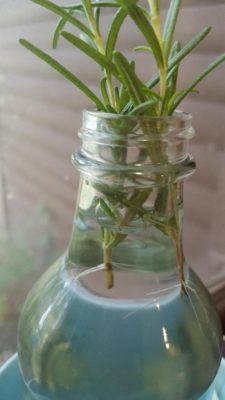How to Propagate Herbs
Have you been wanting to propagate herbs or other plants? Do you think it’s difficult or a waste of time? I’m here to tell you that it’s neither difficult or a waste of time! In fact, propagating herbs is probably the easiest and least expensive way to grow your herb garden.
Sure, you can drop some bucks at the garden center and have all new plants every year. Or you can spend NO MONEY and have new plants for as long as you live!
My choice is the “no money” option…but then I’m just cheap frugal like that!
What does “propagate” mean anyway?
According to Webster’s Dictionary, to propagate means “to breed specimens of (a plant or animal) by natural processes from the parent stock”.
Really, it’s just a fancy word for cloning. Only instead of taking the cells from one plant to create another, it’s done with cuttings.
Why propagate?
To start with, herbs not only jazz up dinner, they also provide nutrition and healing in the form of teas, tinctures and salves. As I mentioned previously, it’s the easiest and cheapest way to get more herbs from a plant you already have. Aaaaaand…it’s faster than starting new plants from seeds. In most cases, cuttings are rooted and ready for transplanting in just a couple of weeks!
What are the best herbs to propagate?
This list is long and not all-inclusive. Propagation can be done on other plants and flowers as well. But for now, we’re focusing on herbs alone. These are the ones I’ve had the most success with:
– Rosemary
– Thyme
– Oregano
– Basil
– Sage
– Mint
– Lemon Balm
Really, propagation will work on just about any plant that is a perennial. A perennial is any plant that will grow for more than just one season. These are seeds (or plants) that you can plant one time and they’ll keep coming back every year.
When should I propagate herbs?
Anytime you’re ready to expand your herb garden! Or move the herb garden indoors for the winter. Or move it outdoors for the spring. You get the picture?
The best time to get cuttings is from spring to summer. This is when most herbs will have new growth. New growth, also called “softwood”, will be green and flexible and has a greater possibility of rooting.
Avoid taking any cuttings from plants that are currently flowering. You want the cut stems energy to be focused on root formation…not flower formation. If this is your only plant and you really want to give propagation a try, cut the required amount of stems and remove any flower heads. Follow the process for rooting and try to be patient.
Can I propagate herbs from another part of the plant?
Yes…but why would you? Semi-hardwood and Hardwood can both be used for propagating herbs. But they may take longer to root. Semi-hardwood is the growth just below the softwood. It’s still flexible but may be turning brown. Hardwood is exactly what it sounds like. Generally, hardwood refers to last years growth. It’s not flexible and may break if you try to bend it.
If you must collect hardwood cuttings, do so before late fall. Additionally, both semi-hardwood and hardwood will require a rooting hormone if you want to see any roots at all. It’s possible for hardwood cuttings to root without a rooting hormone, but it may take longer and there’s less chance of success. If you have time to spare, go for it. But don’t expect fast results.
Since we’re on the subject of a rooting hormone…
Plants have what is called “auxin”…a built-in hormone. Most commercial rooting hormones will contain auxin…and a few other things. Rooting hormone speeds up the healthy root formation and ensures the plant has the best possible chance of producing roots. Again, it’s not guaranteed. Some cuttings just never root. That’s the way it goes sometimes.
I’m all about avoiding chemicals if I can help it. So I skip the commercial stuff and make my own rooting hormone. If you have any of the following items in your home, you’ve already got a “natural” rooting hormone ready to go:
– Honey
– Aspirin
– Apple Cider Vinegar
– Cinnamon
– Aloe Vera (REAL aloe vera…not the commercial gel)
– Saliva (aka “spit”)
Make your own rooting hormone:
– Honey: Add 1 tbsp of honey to 2 cups of boiled water. Stir and let cool. This can be stored in a jar with a tight-fitting lid. Keep it in the fridge for up to two weeks.
– Aspirin: Dissolve one tablet (325 mg is sufficient) in one gallon of water. Stir until dissolved. I found no information on whether leftovers can be stored. Use your best judgement.
– Apple Cider Vinegar: Add 3 tbsp to one gallon of water. Store in a jar and use within two weeks.
– Aloe Vera: Mix equal parts aloe and water. This can’t be saved or stored so mix only what you need for the moment.
– Cinnamon and Saliva: This is as simple as placing some in a small cup for dipping.
For any of the above options that contain water, pour just a little rooting hormone into a separate cup for dipping. This helps avoid contamination of the entire mix.
This is rosemary that I propagated only two weeks ago for the winter garden. Doesn’t she look happy with her tiny little roots!
What is the process for propagating herbs?
Step 1 – Take cuttings in the morning and only from healthy plants. This is less stressful for both the mother plant and the cutting. Use sharp scissors that have been cleaned with alcohol. And if you’re cutting more than one type of plant, clean the scissors between cuttings. This helps prevent the spread of possible disease between plants.
Step 2 – Choose stems that are at least 6-10 inches long and have softwood or semi-softwood growth. Cut just below a leaf node…this is where a leaf joins the stem. Cut the stem at a 45 degree angle to ensure maximum root development. It’s a good idea to take several cuttings of each plant you want to clone. If one cutting doesn’t root for any reason, you’ll have the others to fall back on.
Note: For Basil, you only need about a 4 inch stem that has at least two rows of leaves on it. Basil should be cut above the leaf node…usually where you see new leaves developing.
Step 3 – Using scissors or a fingernail, remove leaves from the bottom two inches of stem. Stripping the plant by running your fingers down the stem can damage the nodes and may prevent rooting. For oregano, remove all but the top two rows of leaves.
Step 4 – Place the stems in a jar of water. Make sure that no remaining leaves are touching the water as this can create rot. If you’re using semi-hardwood or hardwood cuttings, dip the stems in a rooting hormone of your choice and plant in a soil/sand mix.
Step 5 – Whether you use water or soil, place a plastic bag over the stems and jar to create a micro-climate. This keeps the plant moist but not wet. And it should prevent the upper leaves from drying out while you wait for roots. Condensation will develop inside the bag. Be sure to turn it inside out every couple of days. This will help regulate the moisture and prevent mildew.
Wasn’t that easy!
All that’s left is to place your cuttings in a window that has bright but indirect light. Avoid full sun. Depending on the plant you want to clone, you should see roots anywhere from a few days (Basil) to a couple of weeks (oregano and thyme).
Change the water at least weekly or when it looks cloudy. And be prepared for some cuttings to wilt and die. It’s nothing personal…but it does happen on occasion.
So…can I propagate herbs purchased from the grocery store?
Yes, you can…but it’s hit or miss because you don’t know if those herbs have been “treated” prior to shipping to the store. I’ve had success propagating basil purchased from the store. But I can’t vouch for other herbs. But hey, if you purchased a bundle of herbs to use for cooking and still have some leftover, why not give it a shot rather than letting them go to waste.
For those living in a small apartment and have no room for a garden, this is a great way to get started growing your own herbs! All you need is a window sill. Apartments still have windows…right?
What else can I propagate besides herbs?
Lots of things…lavender, azalea, begonia, hydrangea…just about anything that is a perennial. So if you have a flower garden that you’d like to expand, propagation is your friend.
Just think of all the time you’ll save when you start propagating herbs instead of growing them from seed. And look at the money you save by not buying plants every year! Winner-winner chicken dinner!
A final thought…
If all your cuttings end up rooting and you don’t need all of them, give them as gifts! Put them in a pretty pot with a pretty bow. Add a pretty tag on how to use the herb. Maybe it’s just me, but I think potted herbs make a pretty good gift! Pun intended!
Did I miss anything? Do you have a technique for propagating herbs that you’d like to share? If so, please leave a note in the comments below. I’d love to hear from you!
Until next time,
lisa
[/vc_column_text][/vc_column][/vc_row]
Subscribe
If you like what you see, click on the subscribe button so you don’t miss anything!
I promise not to spam you! By clicking the subscribe button, you agree to my privacy policy.










I have pinned this to come back to when I need to know how to propagate my herbs. Thanks for the helpful information!
Hey Andrea, thanks for pinning! Feel free to share with anyone you know who might also find it helpful.